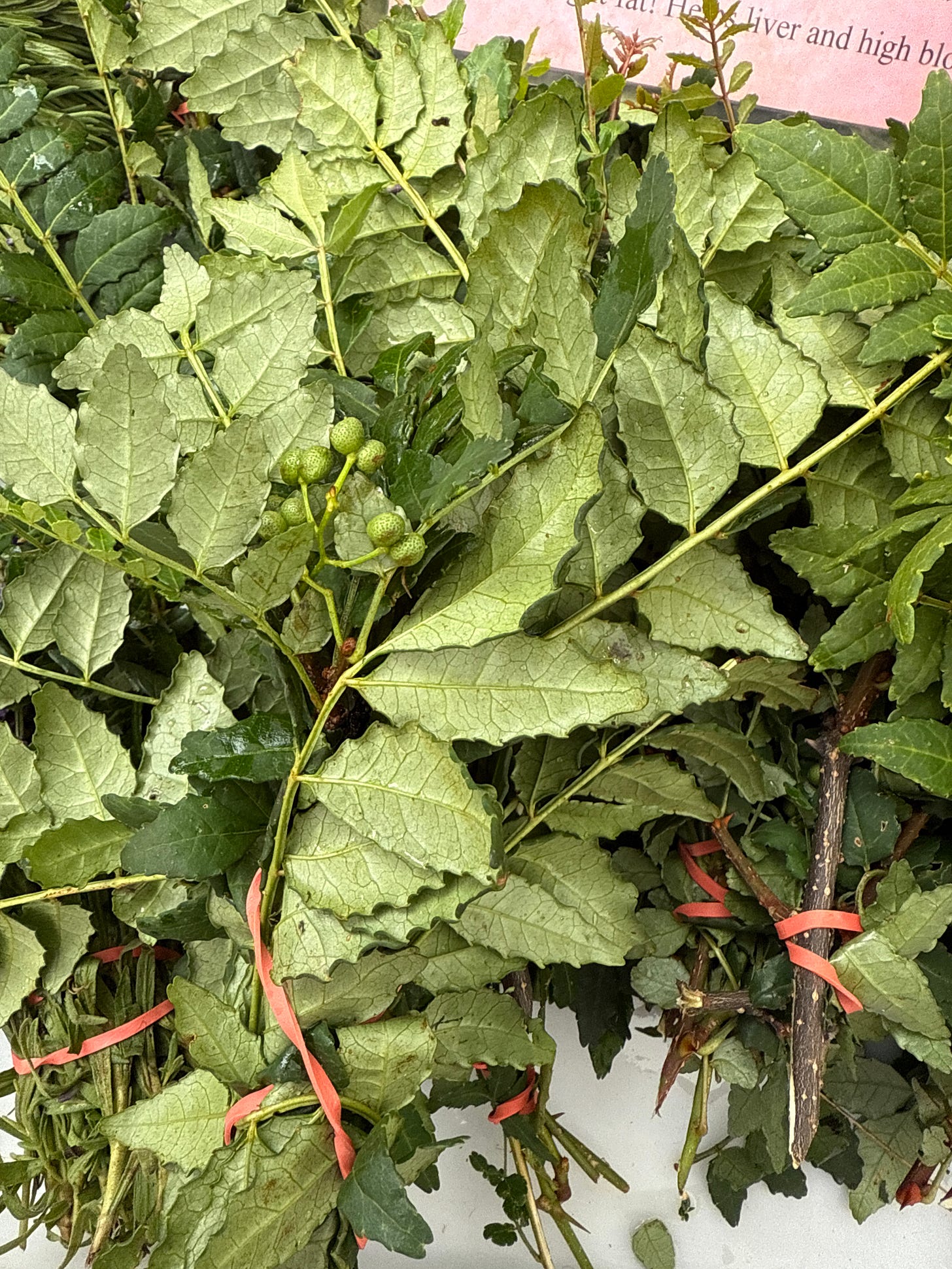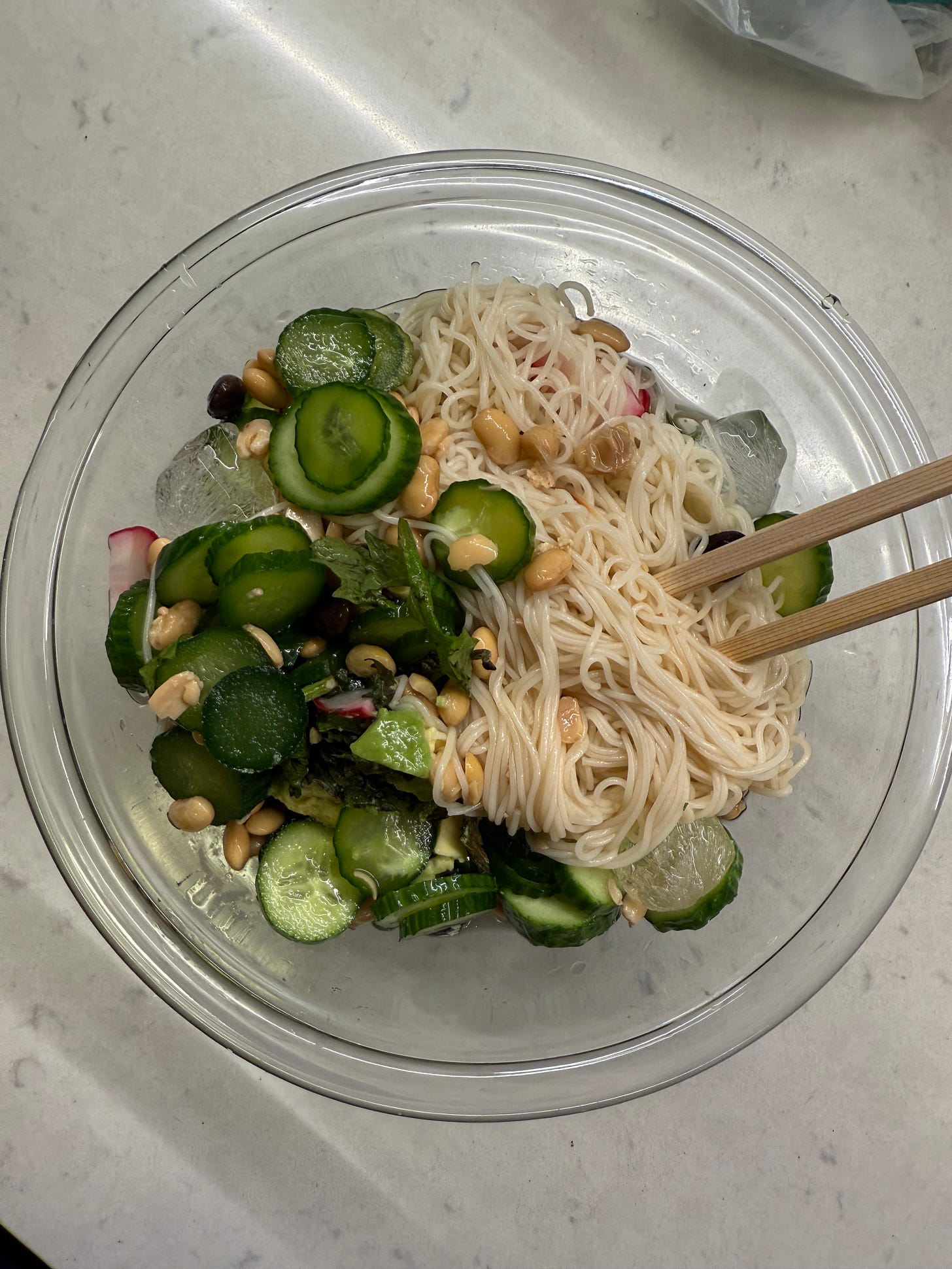Cold soup, salad, noodles - a method
Three courses in one bowl and how to use SANSHO
Happy Friday everyone! Has anyone seen the porcelain flowers at the Frick? If you live in the New York area, you must go.
This is porcelain!
Sansho
So we are back at cold noodles this week because it’s still been too hot to feel like cooking anything, and cooking even these noodles has felt like a triumph, but I could not let go to waste the fridgeful of vegetables from my Suzuki Farm delivery and a Sunday trip to the Carroll Gardens greenmarket.
Lani’s Farm (which sells throughout the city) has an outpost in Carroll Gardens on Sunday, and sells a wide array of Asian produce. This week, as I picked up a big bundle of shiso, I noticed for the first time ever, large bundles of sansho on sale. I hesitated for a second because of the intimidating thorns, but through two big bunches in my basket.
Sansho 山椒 is a Japanese peppercorn of sorts, with a sharp and metholated kick. I disagree strongly that it “tastes like cilantro,” but can’t blame Lani’s. It’s hard to describe a flavor. The most obvious attribute of sansho is that it is slightly numbing, much like the Chinese Sichuan peppercorn, to which it is apparently related. Its leaves can be used to garnish dishes like cold noodles and goma dofu (essentially sesame that is set with starch), but its berries are most commonly used for chirimen sansho1. You might also have tasted it if you have ever eaten unagi in Japan, as unagi is often served with a side of sansho powder to lighten the rich fish.
I had always thought of sansho as Japanese (and fact: when I was checking out at Lani’s with my bunches of shiso and sansho, the man did ask, “are you Japanese?”), but it seems that it is used throughout Asia. Lani’s grows it (so the man told me), so that the Korean owner can have his own stash of sansho (or chopi (초피), as Wikipedia tells me), and that in his native Tibet they use it in achar. If you are a fan of sansho / chopi / etc., please share how you use it!
Despite that, it seemed that the large bundles of sansho were among some of the more untouched items at Lani’s so a quick primer on how I dealt with my bundle (Part 1, because I have yet to figure out the berries). You can of course start to clip off the leaves to adorn your food (be judicious with it - it is strong).
Remove the leaves from the branches. Be careful of thorns.
Remove the berries and put in a separate container to deal with at a later date. You can freeze these if you do not want to deal with them.
Dry them and spread them out on a towel for future use.
I am seeing recipes for cooking down the leaves into a paste, or grinding down the dried leaves with salt to make your own salt-pepper seasoning, but have yet to experiment and have so far been using them on top of my noodles.
1-Bowl Cold Noodles - Salad - Soup
So the noodles in question are more somen noodles that are combined with a mountain of sliced vegetables, ice, cold water, and enough mentsuyu to season (you can also prepare this tofu broth, but I was not so ambitious this week). This essentially creates: 1) a noodle; 2) a salad; and 3) a cold soup of the remaining vegetables and the water / tsuyu broth.
My random bowl (this becomes so bulky that I need to use a literal mixing bowl for a serving) contained cherry tomatoes, cucumbers, avocado, natto, shiso, radishes, and a sprinkling of sansho leaves (of course!).
Some Notes from Brooklyn
We ended up for dinner one night at Rucola, the kind of place that everyone should have in their neighborhood. I always forget just how perfect it is, and I appreciated so much the ratio of this chocolate pudding (1:1 whipped cream to pudding).
On a hot day, do take a minute to buy a custard Italian ice from Court Street Pastry Shop. It is (as the name would imply), much icier than an ice cream and therefore so much more refreshing on these 100000% humidity days.
An accompaniment to rice that consists of small fish (whitebait) cooked with soy and sansho. Shops throughout Kyoto (to which this is native) sell large quantities of this, but you can also make it at home. Due to lack of regular sansho access in New Jersey, my mother often subs orange peel for the sansho. While they are entirely different tastes, the orange adds some of the sharpness that sansho would add.











I am living vicariously - I wish I could get a hold of some fresh sancho!
As a neighbor and Japanese cooking newbie, I am so grateful to have found your Substack. I’ve been wondering what to do with Lani’s sancho - and now I know! Buying some this Sunday,. Now what to do with lotus root…???